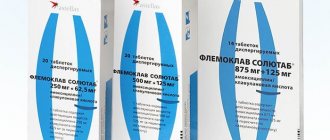"Flemoxin Solutab" is one of the drugs in the category of antibiotics, which is widely used in pediatric practice. The product dissolves well in any liquid - juices, drinking water, milk - and has a pleasant sweetish taste.
Composition of the product "Flemoxin Solutab"
The main component is amoxicillin.
Excipients are:
- dispersible cellulose;
- crospovidone;
- vanillin;
- flavorings (taste identical to tangerine and lemon);
- magnesium stearate;
- saccharin.
Indications for the use of Flemoxin Solutab in childhood
"Flemoxin Solutab" is used in the treatment of respiratory diseases, as well as pathologies of the ENT organs.
Additionally, the medicine can be prescribed during the treatment of bacterial infections affecting:
- surface of the skin and subcutaneous layer of tissue;
- the child's urinary system;
- Gastrointestinal tract.
How to take Flemoxin Solutab
The instructions for children contain the following instructions. A child can take a tablet of the drug:
- swallow whole, simply with any liquid;
- Chew (the drug has a sweetish fruity taste) and drink with plenty of liquid.
If necessary, the tablet can be dissolved in water:
- If you need to get syrup, then take 20 ml of liquid per tablet.
- A suspension will be obtained if the tablet is diluted with 100 ml of water.
Dosage regimen for Flemoxin Solutab (dosage depends on the number of completed years of the child):
- children over ten years of age: 500.0...750.0 mg twice a day with an interval of 12 hours or 375.0...500.0 mg three times a day (every 8 hours);
- from three to ten years: 375.0 mg every 12 hours or 250.0 mg every 8 hours;
- from one to three years: 250.0 mg twice a day or 125.0 mg three times a day.
The dosage depends on the following indicators:
- age;
- baby's weight;
- severity of the disease.
The daily dose is calculated based on the fact that there are 30.0...60.0 mg of the drug per kilogram of the child’s weight. The daily dose should be divided into several doses, most often no more than three.
The duration of the course of taking Flemoxin Solutab depends on the severity of the disease:
- for mild and moderate severity – 5...7 days;
- in severe/protracted form – at least 10 days.
Features of taking the drug
If the child has problems with the kidneys, the doctor reduces the daily dose of the drug. This depends on the severity of the existing pathology and the dosage can ultimately be reduced by half (at the discretion of the specialist).
You can drink Flemoxin Solutab at any time, regardless of meals.
Dr. Komarovsky considers Flemoxin Solutab the safest children's antibiotic. The medication is practically non-toxic, and therefore, if necessary, can be used in children of the first year of life.
And to the question: “Can the drug be given to newborns?” Komarovsky gives a positive answer.
Side effects that accompany taking the drug
Since Flemoxin Solutab belongs to the group of penicillin antibiotics, the following side effects may be observed after taking the drug:
- the appearance of skin rashes like urticaria;
- development of angioedema.
Side effects may also develop from:
- Gastrointestinal tract. This may be an attack of nausea accompanied by vomiting, stool upset, or appetite disorders. Sometimes - an increase in the permissible amount of liver enzymes and the occurrence of hemorrhagic colitis.
- Genitourinary system. Very rarely, interstitial nephritis develops while taking the drug.
- Hematopoietic organs. A blood test may reveal a decrease in the number of platelets and neutrophils. In rare cases, hemolytic anemia is diagnosed.
Contraindications to the use of the drug in childhood
The drug should not be taken if the child has:
- individual intolerance to the component composition of the medication;
- drug allergy to drugs included in the penicillin and cephalosporin series.
In case of existing renal failure, as well as lymphocytic leukemia and mononucleosis, the medicine is prescribed with extreme caution.
Release form
The drug is offered in the form of dispersible - easily soluble in water - tablets of various dosages.
Analogues of Flemoxin Solutab
The main active component of the antibiotic is amoxicillin trihydrate. Analogues of the drug are many drugs, the basis of which is also amoxicillin trihydrate. This:
- "Amoxicillin";
- "Amoxicar";
- "Ospamox", etc.
The difference between Flemoxin Solutab and its analogues:
- release form;
- dispersible – quickly dissolving in water – structure of the drug.
Overdose and measures to eliminate it
Signs of an overdose will be:
- attacks of nausea ending in vomiting;
- intestinal disorder;
- disturbances of water and electrolyte balance.
Symptomatic therapy:
- gastric lavage is performed;
- requires the use of enterosorbents;
- Aqueous solutions of electrolytes are prescribed.
Storage of the drug and expiration date
Store the medicine at a temperature not exceeding +25. Shelf life - within five years from the date of issue.
Summary
Reviews from taking Flemoxin Solutab are either extremely positive or downright negative. Sometimes the medicine helps almost unconditionally, but in some situations it turns out to be useless. It all depends on the individual characteristics of the child’s body. Quite often, the high cost of the drug is cited as a disadvantage.
Expert comment:
- If Flemoxin Solutab is prescribed for the treatment of a complex infection, then only the doctor observing the child can change the dosage indicated in the instructions.
- It is recommended to continue taking the antibiotic for two days after the typical symptoms of the disease disappear.
- If a child experiences severe diarrhea while taking an antibiotic, the drug must be discontinued.
Children's "Flemoxin Solutab" is the safest antibiotic, which extremely rarely causes side effects. The product can be used even during the treatment of children in their first year of life.
Review of the drug "Flemoxin Solutab"
Flemoxin solutab is an antibiotic whose main active ingredient is amoxicillin. The drug is prescribed to children in cases where it is necessary to fight severe infections .
Indications for use of Flemoxin solutaba include infectious diseases of the bronchi, lungs and nasal sinuses; infectious diseases of the excretory system; infectious diseases of the digestive system, as well as purulent wounds.
The dosage of Flemoxin can only be prescribed by the attending physician, since the individual characteristics of the baby and the complexity of his condition are important here. Never try to treat a child without the participation of a doctor!
Directions for use and dosage
After reading the information provided by the instructions for use of Flemoxin, the dosage regimen for the drug becomes clear. For children ten years of age and older , Flemoxin solutab is prescribed in the amount of 500 mg twice a day. You can give 375 mg three times a day.
Patients from 3 to 10 years old should be given 375 mg of the drug in the morning and evening. It is also possible to take Flemoxin Solutab 250 mg three times a day.
For babies from one to 3 years of age, this drug is prescribed at a dosage of 250 mg twice a day or 125 mg three times a day. At the same time, the amount of medicine that a child will receive per day can be calculated more accurately.
On average, it should be 30 mg per kilogram of the baby’s weight. We remind you that this is the amount of Flemoxin calculated for a day, it can be given in 2 or 3 doses. When the disease is severe enough, it is preferable to give the medicine to the baby three times a day.
If your child is sick with a complex disease or it is a recurrent form of infection, you should not be surprised that the doctor increased the daily amount of the drug to 60 mg per kilogram of his weight. In this case, split doses are required, preferably three times a day.
The amount of the drug can be reduced by half if the baby has poor kidney function .
Typically, the course of treatment with Flemoxin can be 5-7 days until complete recovery, with the exception of streptococcal infection, which requires longer treatment - up to 10 days.
The drug can be taken regardless of meals .
If you use Flemoxin in tablets, and you are not very happy with this form of release, then you can dissolve them in water. By dissolving the tablet in 20 ml of water, you will get a medicinal syrup that is quite to the taste of children; if you take five times more water (100 ml), you will get a suspension that children also like, because it has a fruity, pleasant taste.
In what cases is it used?
Flemoxin Solutab has been widely used in pediatric practice for many years to treat bacterial diseases of various localizations. Its active substance penetrates well into the organs of the respiratory system, paranasal sinuses, middle ear, and urinary system, where its bactericidal properties are manifested. "Flemoxin Solutab" can be given to children of any age, even newborns.
Indications for the use of Flemoxin Solutab for children are the following diseases:
- community-acquired pneumonia;
- pharyngotonsillitis, sinusitis, purulent tonsillitis;
- scarlet fever;
- bronchitis, laryngitis;
- otitis;
- urethritis, pyelonephritis, cystitis;
- inflammatory processes on the skin and soft tissues.
The medicine is also used to treat certain infectious diseases (leptospirosis, listeriosis) and sexually transmitted infections (gonorrhea). Very often, Flemoxin Solutab is prescribed in combination with other antibacterial drugs. For example, with Metronidazole to remove Helicobacter pylori. Therefore, this medicine may be indicated for duodenitis, gastric and duodenal ulcers.
A child should be given Flemoxin Solutab, like any other antibiotic, only as prescribed by a doctor. If you use such a medicine on your own, it may, at best, be ineffective, and at worst, cause side effects. Also, you should not take Flemoxin Solutab uncontrollably for acute respiratory infections or influenza in order to prevent complications. The antibiotic has no effect on viral infections and does not contribute to recovery in this case.
Required information
It is worth remembering that Flemoxin Solutab is a fairly powerful drug and can be used for children only when the expected therapeutic effect significantly exceeds the possible risks.
Like any potent drug, it has a lot of unpleasant effects, so the side effects of Flemoxin are:
- Diarrhea, itching in the anus, dyspepsia;
- Development of interstitial nephritis;
- Agranulocytosis, thrombocytopenia;
- Allergy (skin reactions), angioedema, anaphylactic shock.
Contraindications for Flemoxin are mononucleosis and lymphocytic leukemia, individual sensitivity to the drug or other beta-lactam antibiotics.
In case of an overdose of the drug, vomiting, nausea, and diarrhea may occur. As a result, children very quickly develop dehydration of the body with a violation of water-electrolyte balance. This situation requires immediately calling an ambulance and prescribing enterosorbents, saline laxatives, and hydration measures.
Maintaining the child’s health during Flemoxin therapy requires taking vitamins and agents that normalize the intestinal microflora .
Contraindications
Contraindications for taking antibiotics are:
- blood diseases;
- infectious diseases of the digestive system;
- viral infections of the respiratory system;
- allergic diseases;
- individual intolerance to beta-lactam antibiotics.
Use the medicine with caution in severe liver and kidney diseases. In case of renal failure, dose adjustment is necessary in accordance with the results of laboratory tests.
Flemoxin Solutab
Information about the drug is generalized, provided for informational purposes and does not replace official instructions. Self-medication is dangerous to health!
Vilprafen 1000: instructions, analogues, reviews
tablet core 755 mg: croscarmellose sodium MCC starch pregelatinized silicon dioxide povidone stearic acid magnesium stearate talc quinoline yellow E659
Flemoxin Solutab (tablets 125 mg, 250 mg, 500 mg and 1000
As a rule, these diseases are caused by Streptococcus pyogenes, which are highly sensitive to Amoxicillin. Standard treatment protocols indicate that for bacterial tonsillitis Flemoxin solutab is the drug of choice. However, if the disease is recurrent in nature, that is, it recurs periodically over, for example, one year, then preference is given to a combination with clavulanates, as well as macrolides or cephalosporins. You need to know that Klacid SR is recommended for the treatment of infections of the upper and lower respiratory system, as well as skin and soft tissues. In principle, for all the other infections listed above, Klacid SR can also be used, but this should be done only if it is not possible to use regular Klacid, which is preferable in these cases. Strong inducers of isoenzymes of the cytochrome P955 system, such as efavirenz, nevirapine, rifampicin, rifabutin and rifapentine, can accelerate the metabolism of clarithromycin and, thus, reduce the concentration of Klacid in plasma and weaken its therapeutic effect, and at the same time increase the concentration of the 69-OH-clarithromycin metabolite , which is also microbiologically active. Since the microbiological activity of clarithromycin and 69-OH-clarithromycin differs against different bacteria, the therapeutic effect may be reduced when clarithromycin is used together with enzyme inducers. Amoxicillin was previously widely used to treat uncomplicated cases of gonorrhea. But recently, penicillin-resistant strains of Neisseria gonorrhoeae have emerged, so Flemoxin is often replaced with another antibiotic. This substance is active against a variety of gram-positive and gram-negative bacteria, including streptococci and staphylococci, clostridia, bacilli, listeria, and salmonella. But pathogenic microorganisms that produce beta-lactamases are insensitive to this antibiotic. Use during pregnancy and lactation: The drug may be prescribed during pregnancy and lactation if the expected benefit of therapy for the mother outweighs the risk of side effects in the fetus and infant. Children's Flemoxin is a tablet with a dosage of amoxicillin of 675 and 755 mg. The instructions for children indicate that it is more convenient for a younger child to give a syrup or suspension; older children can swallow the tablet whole or after chewing it.
- home
- Drugs
- Flemoxin Solutab
Flemoxin Solutab belongs to the penicillin group of antibiotics. The active ingredient of the drug is amoxicillin trihydrate.
Has a wide spectrum of action:
- gram-positive and gram-negative bacteria (streptococci, clostridia, neisseria, Helicobacter pylori);
- less active against E. coli, enterococcus, shigella, and the causative agent of cholera.
information Flemoxin is well absorbed (93%), which is ensured by its special form, is not destroyed in the acidic environment of the stomach, and food intake does not affect its bioavailability. The drug is excreted by the kidneys, a small amount may pass into breast milk.
Compatibility with other tools
Flemoxin Solutab can be combined with other antibiotics. A synergistic (that is, reinforcing each other) effect is observed when taken together with the following drugs:
- cephalosporins;
- "Vancomycin";
- "Rifampicin";
- aminoglycosides;
- "Cycloserine."
However, in combination with some antibacterial agents, on the contrary, an antagonistic effect appears. Therefore, Flemoxin is not recommended for use in combination with the following drugs:
- macrolides;
- "Chloramphenicol";
- "Tetracycline";
- sulfonamides;
- lincosamides.
Also, you should not take amoxicillin together with anticoagulants. This is due to the fact that Flemoxin Solutab suppresses intestinal microflora, which, in turn, leads to a decrease in the synthesis of vitamin K and the prothrombin index.
In case of concomitant kidney diseases, it should be taken into account that some medications slow down the excretion of amoxicillin by the kidneys. Therefore, Flemoxin Solutab is used with caution in combination with diuretics, non-steroidal anti-inflammatory drugs, and Allopurinol.
Also, some medications can slow down the absorption of Flemoxin Solutab in the gastrointestinal tract. These include: antacids, laxatives, aminoglycosides. At the same time, ascorbic acid, on the contrary, increases the bioavailability of amoxicillin.
Side effects of Flemoxin when treating a child
dangerous The most common side effects of penicillin antibiotics, including Flemoxin Solutab, are allergic reactions in the form of rash, urticaria, and angioedema.
There are also side effects on:
- Digestive system : nausea, vomiting, diarrhea, changes in appetite and taste, less often - increased liver enzymes, in rare cases - the development of hemorrhagic and pseudomembranous colitis;
- Urinary system : very rarely, interstitial nephritis may develop;
- Hematopoietic organs : possible decrease in the level of platelets, neutrophils, agranulocytosis, very rarely - hemolytic anemia.
Side effects
"Flemoxin Solutab" is one of those drugs that is well tolerated by children. Very rarely it causes the following side effects:
- nausea, vomiting, stool disorders;
- liver dysfunction;
- inflammation of the intestines due to the proliferation of clostridia;
- dysbacteriosis, stomatitis;
- kidney damage;
- changes in blood composition;
- allergies of varying severity.
Most often, side effects occur when the dosage regimen is violated or the dosage is increased. Therefore, during treatment you should follow your doctor’s recommendations.
Mode of application
The medicine has a pleasant fruity taste. The tablet can be taken in the following ways:
- swallow whole;
- chew;
- dissolve in 20 ml of water to prepare a suspension or in 100 ml to prepare a solution.
advice The dose of the drug is selected depending on the age, weight of the child, as well as the severity of the disease. The daily dose for children is 30-60 mg per 1 kg of body weight, divided into 2-3 doses.
Standard schemes for children of different ages:
- adults and children over 10 years old : 500-750 mg 2 times a day (every 12 hours) or 375-500 mg 3 times a day (every 8 hours);
- children from 3 to 10 years : 375 mg every 12 hours or 250 mg every 8 hours;
- children from 1 to 3 years : 250 mg 2 times a day or 125 mg 3 times a day.
The average treatment period is 5-7 days, for severe infections and a long course of the process - up to 10 days.










